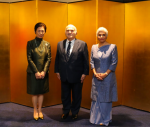You are here
Kennan’s revenge
May 24,2014 - Last updated at May 24,2014
Earlier last month, Russian President Vladimir Putin announced that gas giant Gazprom would start demanding payment a month in advance for the supplies that it sells to Ukraine.
The British newspaper The Observer published, in response, a striking cartoon showing Putin sitting on a throne of outward-pointing daggers, turning off the Ukraine gas tap while saying: “Winter is coming.”
The background was bright red, and a hammer and sickle and a skull were planted on Putin’s breast. For some, at least, the Cold War is back.
But, before we drift into Cold War II, we would do well to recall why we had the first one.
The end of communism removed one important reason: the Soviet Union’s expansionist thrust and the Western democracies’ determination to resist it. But other reasons remain.
American diplomat George F. Kennan identified them as neurotic insecurity and Oriental secretiveness on the Russian side, and legalism and moralism on the Western side.
The middle ground of cool calculation of interests, possibilities and risks remains elusive to this day.
Kennan is reckoned to have laid the Cold War’s intellectual foundation — at least in the West — with his “long telegram” from Moscow in February 1946, which he followed with his famous Foreign Affairs article, signed “X”, in July 1947.
Kennan argued that long-term peace between the capitalist West and communist Russia was impossible, owing to the mixture of traditional Russian insecurity, Stalin’s need for an external enemy and communist messianism.
Russia, Kennan argued, would seek to bring about the collapse of capitalism not by an armed attack, but by a mixture of bullying and subversion.
The correct response, said Kennan, should be “containment” of Soviet aggression through the “adroit and vigilant application of counterforce”.
During president Harry Truman’s administration, United States officials interpreted Kennan’s view as requiring a military build-up against a potential communist invasion of Western Europe.
This gave rise to the Truman Doctrine, from which sprang the logic of military confrontation, NATO, and the arms race.
These developments dismayed Kennan, who claimed that containment was meant to be economic and political, not military.
He was one of the main architects of the post-World War II Marshall Plan. He opposed the formation of NATO.
After Stalin’s death, Kennan looked forward to fruitful negotiations with a “mellowing” Soviet system under Nikita Khrushchev.
He came to regret the uses to which the ambiguous language of the “long telegram” and his “X” article had been put, lamenting that democracies could pursue a foreign policy only on the “primitive level of slogans and jingoistic ideological inspiration”.
In retrospect, one might ask whether it was NATO or US economic and political support that prevented Western Europe from embracing communism.
At any rate, both sides convinced themselves that the other represented an existential threat, and they both built up colossal arsenals to guarantee their security.
Until the Soviet Union collapsed, each brief period of “détente” was followed by a new arms build-up.
There was something insane about the whole business, and one is left with the disquieting thought that NATO prolonged the Soviet Union’s life by handing it a ready-made enemy to replace Nazi Germany.
To understand how Russians regard Ukraine today, one needs to view events there through this lens. Following its “victory” in the Cold War, the West made a serious mistake by refusing to concede any form of regional hegemony to Russia, even in countries like Ukraine and Georgia that had once formed part of the historic Russian state.
Rather, under the banner of democracy and human rights, the West actively sought to pry the ex-Soviet countries from Russia’s orbit.
Many of them were eager to escape the Kremlin’s gravity, and NATO expanded eastward into the former Soviet bloc in Central Europe, and even into the former Soviet Union, with the admission of Estonia, Latvia, and Lithuania.
In 1996, the 92-year-old Kennan warned that NATO’s expansion into former Soviet territory was a “strategic blunder of potentially epic proportions”.
These Western thrusts undoubtedly inspired Russian paranoia, reflected today in Kremlin-fuelled conspiracy theories about Ukraine.
And, just as Kennan warned against a foreign policy that was “utopian in its expectation, legalistic in its concept… moralistic… and self-righteous”, the goal of Western policy today should be to find the means to work with Russia to stop Ukraine from being torn apart.
This means talking and listening to the Russians. The Russians have presented their ideas for resolving the crisis.
Broadly, they propose a “neutral” Ukraine on the model of Finland and a federal state on the model of Switzerland.
The first would exclude NATO membership, but not admission to the European Union. The second would aim to secure semi-autonomous regions.
Such proposals may be cynical; they may also be unworkable.
But the West should be urgently testing, exploring and seeking to refine them instead of recoiling in moralistic horror at Russia’s actions.
Suspended between paranoia and moralism, sensible diplomacy has a hard job.
But it should not need the upcoming hundredth anniversary of the second bloodiest war in history to remind our statesmen that low-level events may spin irretrievably out of control.
The writer, a member of the British House of Lords, is professor emeritus of political economy at Warwick University. ©Project Syndicate, 2014. www.project-syndicate.org













